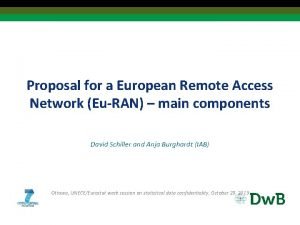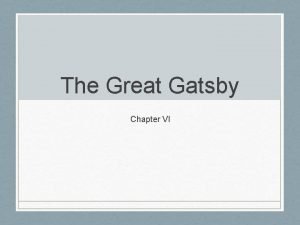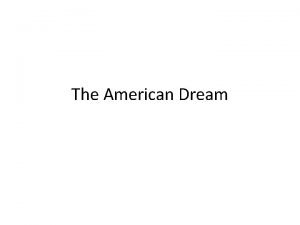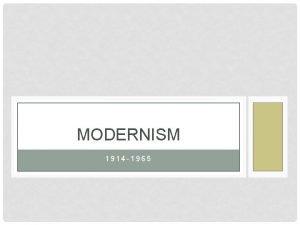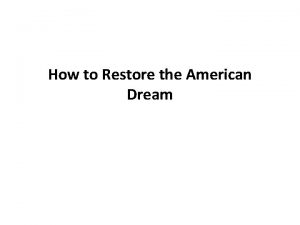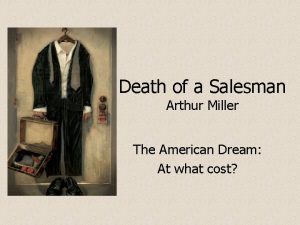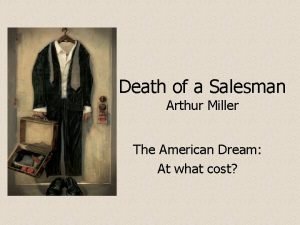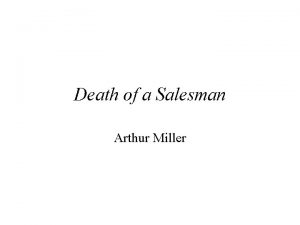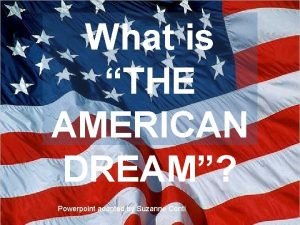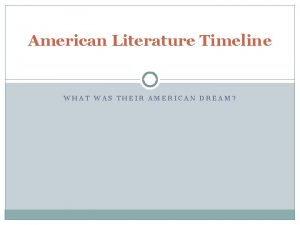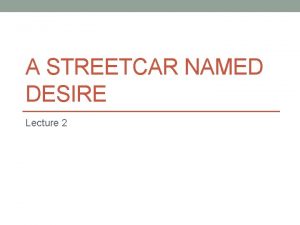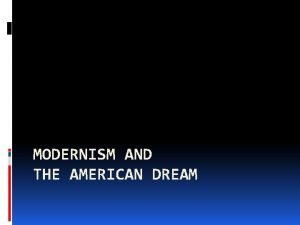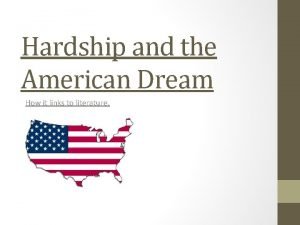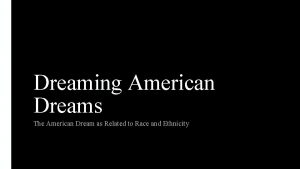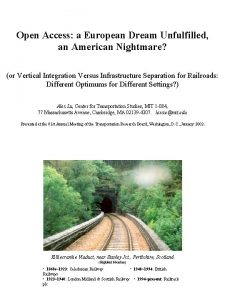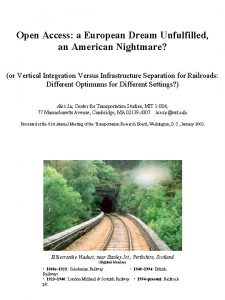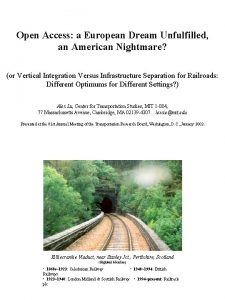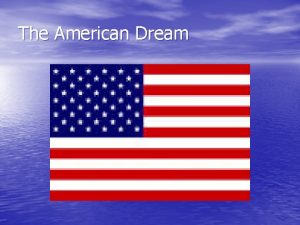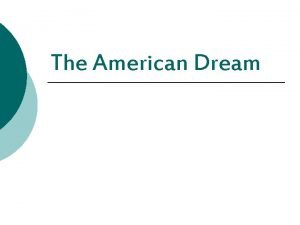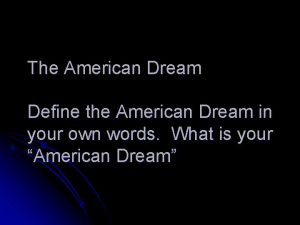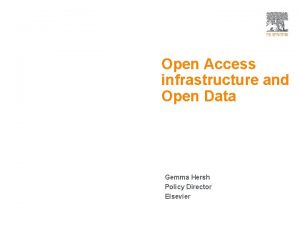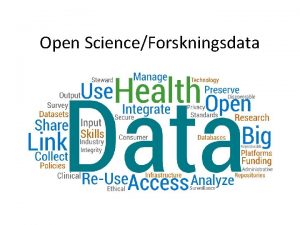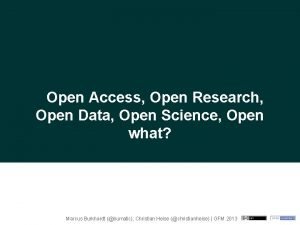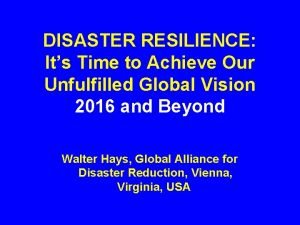Open Access a European Dream Unfulfilled an American



























- Slides: 27

Open Access: a European Dream Unfulfilled, an American Nightmare? (or Vertical Integration Versus Infrastructure Separation for Railroads: Different Optimums for Different Settings? ) Alex Lu, Center for Transportation Studies, MIT 1 -084, 77 Massachusetts Avenue, Cambridge, MA 02139 -4307. lexcie@mit. edu Presented at the 81 st Annual Meeting of the Transportation Research Board, Washington, D. C. , January 2002. Killiecrankie Viaduct, near Stanley Jct. , Perthshire, Scotland. (Highland Mainline) • 1860 s~1923: Caledonian Railway • 1948~1994: British Railways • 1923~1948: London Midland & Scottish Railway • 1994~present: Railtrack plc

Alex Lu Open Access: a European Dream Unfulfilled, an American Nightmare? THESIS • Open Access is a vehicle for harmonization of operating practices, standardization of infrastructure, and possible wholesale realignment of institutional boundaries in Europe. • Open Access is an unnecessary complication in North America. OUTLINE • Theoretically, vertical integration is the more efficient way to operate a railroad. • The inherent efficiency is not always realized where there is a lack of competition. • Open Access advocates promote infrastructure separation as a framework under which different carriers may compete on the same routes. • Infrastructure separation is operationally cumbersome, requiring many supervisors and mediators, and may create many stakeholders with often conflicting interests within a confusing web of contracts. • Historically, such a framework had not been necessary as multiple vertically-integrated private companies with roughly parallel mainlines competed with each other for through-traffic. • Open Access allows the shipper (or passenger) to choose the carrier independently of the routing. Such a framework is only necessary where alternative routings are, for whatever reason, not effective competitors. • In Europe, there are many routing restrictions for any given origin-destination market. In North America, there are less routing constraints. • Consequently, the degree of infrastructure separation required to achieve an efficient market is higher in Europe than then are in North America. • As routing restrictions are removed on a pan-European basis, the European Union may revert to a more vertically-integrated organizational regime to take advantage of the inherent efficiency in direct carrier control of infrastructure. • Open Access is a vehicle for harmonization of operating practices, standardization of infrastructure, and possible wholesale realignment of institutional boundaries in Europe. • Open Access is therefore an unnecessary complication in North America. Note: a full-colour copy of this handout may be downloaded from: http: //web. mit. edu/lexcie/www/trb/handouts/ Monday, January 14, 2002.

Alex Lu Open Access: a European Dream Unfulfilled, an American Nightmare? METHODOLOGY The Comparative Study of Transportation Systems explicitly attempts to relate every element of one transportation system to to the same element in another, in both quantitative and qualitative terms. The focus of such study are the differences between the systems. Having determined and eliminated the similarities among the two apparently very dissimilar systems, the resulting differences allows us to determine whether the practice in one system may be applied to another to improve it — and if not, why not? The researcher attempts to create a framework to describe the attributes of the two systems being compared. Through interviews with knowledgeable individuals, personal observations of the systems in question, supplemented by research of a general nature in any professional and marketing publications published by the industry as well as more specific literature search of a technical nature, the researcher achieves an understanding of both systems in greater depth than ordinarily possible. The researcher is then able, through a process of rational analysis, derive analogies between the two systems, eliminate the similarities, and highlight the differences for further investigation. Such work enables the cross-pollination of best-practice across a wide variety of transportation systems. In the present study, this methodology is applied to a comparison between the infrastructure-separated European Railway Network and the vertically-integrated North American Railroad Network. Specifically, the following areas were investigated: Differences in System Design • • Core Target Market (Freight or Passenger? What kind of commodities, what kind of trips? ) Physical Differences (e. g. Dimensions) Technical Differences (e. g. Signalling, Traction Technologies; Compatibility and Standardization) Operational Differences in Geographical Environment • Natural Barriers (presence or absence thereof; method of conquest) • Differences in Network Configuration: Specialization of Mainlines, past Rationalizations, Strategic Bottlenecks, Connectivity to Marine Transportation. Differences in Cultural Environment • • Political Barriers Historical Regulatory Policy Differences Difference in Urban Development and Planning Process (leading to different demand patterns) The Role of the Railroad in the Nation-Building Process With detailed knowledge of the differences between the systems, the researcher proceeds to ask the question, “what, if any, implication does such a difference have upon the optimal institutional organization of each of the rail systems? ” Specifically, the issue of whether open access or vertical-integration is suitable for the systems in question is addressed, using the insight gained through detailed knowledge of the differences between the systems in question. Monday, January 14, 2002.

Alex Lu Open Access: a European Dream Unfulfilled, an American Nightmare? WHAT IS OPEN ACCESS? Open Access is the concept whereby trains owned by one party are permitted to operate over infrastructure owned by another. It does not necessarily (but often does) imply infrastructure separation, when the carriers own no fixed assets but instead purchase operating rights (i. e. departure slots) from infrastructure authorities. European Union directive 91/440/EC mandated infrastructure separation for railroads throughout the Union, with Britain spearheading the drive to restructure in the Railways Act (1994). Institutional behaviour under such a regime could be summarized: • • Operationally complex, responsibilities unclear Low entry barrier for new carriers Consumer chooses carriers independently of routing Carriers’ tendency to consider only short-run costs Vertical Integration is the opposite scenario; the carrier owns the track and serve only those routes, as in North America: • • Operationally efficient and safe High entry barrier for new carriers Consumer chooses a route-carrier combination More incentive to account for long-run costs In this late 2000 Scottish scene at Inverness, it is not always entirely clear which of the train operators, the maintenance contractor, or the infrastructure authority is responsible when a “systems delay” occur due to a combination of poor dispatching following a signal or vehicle failure. Despite the myriad of motive power seen here, the ex. Baltimore & Ohio Mainline is owned by CSX Transportation who maintains the track, dispatches the trains and employ the operating crews. Occasionally, a Burlington Northern Santa Fe train may be seen operating here under trackage rights agreement with CSX is ultimately responsible for the performance of this line. Monday, January 14, 2002.

Alex Lu Open Access: a European Dream Unfulfilled, an American Nightmare? THE GOAL OF THE RAIL REGULATOR What does the Rail Regulator want? It is important to note that the goal of rail regulators in different parts of the world may be different. The goal of the regulator is heavily influenced by the local political conditions, ideological beliefs, as well as existing infrastructure and the desire to modify it. Regulatory decisions in the past has shaped the network of today; similarly, if the regulator wishes to influence the shape of the network in the future for political or other reasons, then a different regulatory regime may be adopted. The European Aspirations The American Dream Efficient pan-European intermodal transportation Efficient and profitable transcontinental railroad systems — without service failures High-speed passenger rail service between major population centres Cultural integration within the European Union Consolidation of manufacturing facilities to compete internationally Common Goal: Efficient Rail Transportation. But… How do you achieve that? Nationalization and Rationalization (pre-Maarstricht, 1992) Yes, How? Parallel Competition: Merger and Consolidation. And Why? Few Routing Restrictions Open Access (post-Maarstricht) Many Routing Restrictions What do you mean… by Routing Restrictions? Monday, January 14, 2002. Increased interstate and international commerce and economic growth

Alex Lu Open Access: a European Dream Unfulfilled, an American Nightmare? WHY ARE EUROPEANS PICKY ABOUT THEIR ROUTE? Railroads were a ‘retro-fit’ for Europe. By the time rail technology came to pass, many of the urban centers in Europe were already highly developed. Because of the higher population density, major cities in Europe are much closer together than they are in North America (except perhaps in the Northeast, but even in the Northeast of USA, the population density is lower than that in the heavily populated urban belts in Europe). The existing centers of population and gave rise to a travel demand pattern which is much different in Europe and North America, which in turn drove a different network structure. As high-speed rail technologies were developed throughout the latter half of the 20 th Century, European Railways were able to compete effectively against the automobile due, in part, to the shorter distance between urban centers and higher urban density. This gave rise to an European Railway system which is firmly focused on passenger, whilst the American Railroad system became freight-oriented. The American Railroad benefited from the generous loading gauges and the relatively more distributed economy and larger scale manufacturing activities, thus they tailored their network in response to freight customers’ needs. By comparing the intrinsic differences between the requirements of the passengers versus that of shippers, it became clear that the demands of the passenger led to a much more restrictive choice of routes between any given origin and destination. The network structure resulted from the early railway development in Europe exacerbates this effect. The net result is that European passengers have much less choice of plausible rail route between any two points than American logistics managers. European Railways are Passenger-Focused American Railroads are Freight-Oriented Passengers don’t like to wait — many prefer to go by the most direct route. Freight doesn’t really care if it has to wait an hour or so — especially not coal. Passengers don’t like to transfer — alternative routings may involve transfers. Passenger journeys tend to be under five hours — an additional hour by an alternative route is a significant percentage of total trip time (and is associated with a large disutility) Passengers like to have a frequent service — distribution of services over many routes results in less frequency for intermediate stations. Passengers like to board at intermediate stops — e. g. , commuters. The routing other than the one that takes the commuter home is useless! Passengers have idiosyncratic preferences — “Sleep like a kitten, only on the Chessie System” Freight trains have to wait for passenger trains to pass in some places, even at night. (Transrail 37 410 with Scot. Rail local service. ) Monday, January 14, 2002. Freight doesn’t really care if it has to transfer — as long as you can do it cheaper, including the cost of transfer. Freight tends to go half-way across the continent — an additional few hours doesn’t really make much difference, when the shortest Los Angeles to Chicago timing is 34 hours. Freight doesn’t really need short headways — so you can send more of the transcons via the cheaper routing, the decreased frequency of intermediate stops will hardly be noticed. Freights tend not to board at intermediate stops — on the railroad at least, they tend to go from hub to hub, with intermodal pick-up/delivery. There is no “commuter railfreight”. Freight doesn’t have idiosyncratic preferences — it doesn’t even know where it’s going. You can even make oranges into juice, concentrate, or bottles of juice before shipping it!

Alex Lu Open Access: a European Dream Unfulfilled, an American Nightmare? COMPARISON OF DEMAND PATTERN AND NETWORK Different target markets have different demand patterns and networks. In North America (outside the Northeast), the railroad network created these demand patterns by inducing settlement. In Europe, the railway network was built to accommodate pre-existing demands. Monday, January 14, 2002.

Alex Lu Open Access: a European Dream Unfulfilled, an American Nightmare? COMPARISON OF PATTERN OF TRADE AND CULTURAL INTEGRATION Different patterns of trade and cultural integration drove different demands. Because of the greater cultural compatibility in North America, transcontinental traffic are a larger proportion of total demand than local traffic. Up until recently, it is rare to see French-manufactured electrical appliances in British homes, due, in part, to the differences in electrical systems; but the fact that the toast lies perpendicular to the toaster in an English appliance and parallel in the French counterpart meant that there is relatively little demand for toaster flows between Britain and France. Trends in European Cultural Integration § Centralized Regional Activity Centers § Language Barriers § Natural Barriers — bodies of water and mountain ranges § Historical Political Barriers § Economies of Scale not exploited; focus on regional self-sufficiency. Trends in North American Cultural Integration § Regional activity focus less centralized than in Western Europe — strong regional identity coupled with willingness to trade § Lack of language barriers, except in Quebec § Natural barriers conquered by multiple trunk railroads, interstate highways and strong aviation industry § Lack of border controls between states since Colonial Period § Manufacturing is centralized to exploit economies of scale — strong interstate commerce Monday, January 14, 2002.

Alex Lu Open Access: a European Dream Unfulfilled, an American Nightmare? WHY DOES PASSENGER FOCUS LEAD TO ROUTE SPECIFICITY? In the same way that air carriers with the direct flight between any given two origin-destination pairs will tend to dominate that market. . . Despite a 25% shorter journey time from Leeds to Southampton, compared the direct route via Birmingham New Street, it is unlikely that passengers from Lancaster will drive to Leeds to meet the train on a parallel mainline. Because of the undesirability of transfers, Virgin Trains would have a virtual monopoly on the Lancaster-Southampton origin-destination market if it owned the track and precluded other operators from operating along that corridor. Because transfers or alternative (longer-distance) routings usually lead to significantly longer journey times, it is difficult for any operator other than that of the direct route to attain any significant market share. This is especially the case where the waiting time is a significant portion of the total trip time. Monday, January 14, 2002.

Alex Lu Open Access: a European Dream Unfulfilled, an American Nightmare? COMMODITY TYPE AFFECTS ROUTE SPECIFICITY IN FREIGHT In the freight case, only unit-train bulk commodities which are not economical to transload require routespecific terminal access — and only on the terminal access portion of the trip, not for the line-haul portion of the trip. Here, the price is likely to be the biggest driver in routing decisions, since the shipper does not care how many times the freight is transloaded (or interchanged between railroads) — unless the goods are lost or damaged. Neither railroad are able to monopolize any given market, since the customer is not necessarily specific about the origin-destination requirements for the rail segment of the logistics network. Although, in the case of unit coal trains, unless the terminal trackage is owned by the customer, jointly owned by competing railroads, or an independent concern, risk of market-power abuse exists. In this case, open-access is no more of a satisfactory solution (from the shipper’s standpoint) than joint-ownership or independent ownership. In any case, risk of oligopolistic market-power abuse exists, albeit open-access will permit shippers to provide their own transportation. Experience has shown that shippers are often reluctant to do this in a rail environment, but the mere possibility may be sufficient incentive to induce acceptable service from railroad carriers. American Class I carriers have generally cooperated in making efficient routings available for unit-trains under trackage-rights agreements. In general, North American shippers have not suffered from the effect of inefficient routings resulted from institutional boundaries the way European bulk-shippers have. Monday, January 14, 2002.

Alex Lu Open Access: a European Dream Unfulfilled, an American Nightmare? THE EVOLUTION OF THE RAILROAD (or Other Differences in System Design) The existing infrastructure often influence strategic analyses of ‘what railroad technology is good for’. The result of such strategic analysis over a period of time tends to result in focused investment in making the railroad even better for what it already does well — exploiting the niche, whilst the investment for the other markets tend to be minimal. This has the effect of creating a very polarized system design which suits one particular market segment, which further reinforces its position in that market. The demand technical characteristics thus tend to influence each other, and isolated systems may diverge from each other in terms of system design and target markets. Examples of Physical Differences Siding Length: Typical sidings on secondary track (and some mainlines) in Britain are about 2, 000 ft long. Most U. S. Class I’s and Regionals build a siding of at least 6, 000 ft in length when they build one, and 12, 000 ft sidings are commonplace. In Britain, a 12, 000 ft siding would be classified as a “dynamic loop” which would be signalled to permit trains to pass each other at speed! Loading Gauge: Overhead wires for electrification on most mainlines have a minimum clearance of 13’ 8”. The safety clearance at 25 k. V is around 2’ which mean that the maximum loading gauge from railhead stands at 11’ 8” at the most. Usually, as part of the electrification scheme, structures have In Britain, the loading gauge is very restrictive, had to be raised to allow the extra clearance for electric wires. there are very short distances between signals, and The vertical loading gauge are even more restrictive on nonthe sidings were not designed for mile-long freight trains. electrified lines. The fact remains that the majority of the (Mound Tunnels MP 0. 4, Edinburgh Waverley, Scotland. ) British Rail network was only ever designed for single-level Examples of Technical Differences trains. Signalling: Route signalling had always been the traditional British-European way of keeping trains apart. To increase capacity under route signalling, you simply subdivided the existing blocks to make the blocks shorter. More blocks would allow more trains per hour, since only one train is permitted within one block at any one time. The length of blocks are only constrained by the braking capacity of the trains. Speed signalling with cab signals had been deployed in North America since the early part of the 20 th Cenutry, especially by the Pennsylvania. With speed signalling and cab signals, it is possible to add aspects in order to increase capacity, instead of shortening the blocks. It is evident in the designs of many British-standard signalling installations in the 1960’s and 70’s (Solid State Interlocking with track-circuiting) that the possibility of operating a train whose length is longer than a signalling block was either never considered or purposely ignored. British Rail was very keen on automation and allowing the signalling system to do bulk of the work, whilst the American Railroads tended to place the responsibility of safe operations firmly in the hands of the dispatcher. The net result was that British Rail came up with a system which is a lot better automated but a lot less flexible than the American Railroads, because some of the operating assumptions (e. g. no train will be longer than one signalling block length) was hard-wired into the logic within the signalling circuity. The unexpected occupation of a track-circuit was usually considered a sign of a mishap — a runaway train, a train-separation, an operator using a track-circuit actuator clip, or a derailment. Monday, January 14, 2002.

Alex Lu Open Access: a European Dream Unfulfilled, an American Nightmare? WHY ARE THESE DESIGN DIFFERENCES SIGNIFICANT? As a result of these design differences, in Britain, trains tended to have evolved to be small and short — sounds a lot more like an express passenger train than a heavy freight unit-train. The loading gauge on the railways were laid down in Victorian times; this parameter continue to affect the economics of intermodal services today, due to the high costs of gauge enhancements. Here, it is evident that technology has affected the target market, which in turn pushed technological development towards that which is suitable for passenger operations. As already discussed, the passenger market is a lot more route-specific than the freight market. These system design differences further emphasizes and continually reinforce the passenger focus and routespecificity, making it practically impossible for anyone to invest in an alternative route to bring about competition with the incumbent routes. Monday, January 14, 2002.

Alex Lu Open Access: a European Dream Unfulfilled, an American Nightmare? EUROPEAN MAINLINES ARE HIGHLY SPECIALIZED Monday, January 14, 2002.

Alex Lu Open Access: a European Dream Unfulfilled, an American Nightmare? NORTH AMERICAN MAINLINES ARE LESS SPECIALIZED Monday, January 14, 2002.

Alex Lu Open Access: a European Dream Unfulfilled, an American Nightmare? DIFFERENCES IN DEGREE OF STANDARDIZATION European Railways are Poorly Standardized • • • American Railroads are Highly Standardized (AAR worked to harmonize railroad technology since the last century) Four main types of electrical supply systems Many types of control and signalling systems At least seven different types of incompatible drawgear Loading gauges differ between countries and between lines Incompatible vehicles safety-certificates between systems • • • GE and EMD power can work in multiple Standard radios used for crew communication Regional (eg Canadian) restrictions are few and far between Interline waybill permits smooth interchange of traffic Rule book is at least 95% compatible between carriers What do all these differences have to do with Open Access? Standard American Locomotive, hauling a Standard American Train… (CSX 610 at MP 66. 5 near Deshler, OH. ) Answer In Europe, routing restrictions preclude parallel competition by vertically-integrated carriers, requiring Open Access for consumer choice. Monday, January 14, 2002. In North America, lack of routing restrictions encourage head-to-head competition by parallel carriers, resulting in efficiency and improved service.

Alex Lu Open Access: a European Dream Unfulfilled, an American Nightmare? EXTENT OF INFRASTRUCTURE SEPARATION Open access is not an all-or-nothing concept. Various organizational regimes have been developed which represents different relationships between the infrastructure operator and the vehicle operator. Depending on the needs of the ultimate customer (travellers and shippers), and interaction with other modes, different organizational regimes will yield the best results. Examples from Each of the Organizational Regimes 1. CSX owns most of the mainline trackage on the Florida peninsula, no other Class I’s operate in that area. 2. UP intermodals travel over BNSF trackage between Chicago, IL and Kansas City, MO. 3. Metra’s Fox Lake and Elgin lines in Chicago, IL are dispatched by the Canadian Pacific. 4. Amtrak and NJ Transit jointly dispatch Penn Station, New York, NY. 5. Indiana Harbor Belt, Terminal Railroad Association of St. Louis, and Chicago Belt Railway are jointly owned by numerous Class I’s. Spokane, Portland & Seattle was jointly controlled by Northern Pacific and Great Northern. 6. In Canada, terminal trackage rights within 18 miles of an interchange point is mandatory (although, it is not widely used). 7. In Britain, any carriers may operate over any trackage for which they satisfy the safety requirements. Monday, January 14, 2002.

Alex Lu Open Access: a European Dream Unfulfilled, an American Nightmare? Why else is Open Access a European Dream? ISSUES OTHER THAN ROUTING RESTRICTIONS Surely joint ownership or mandated trackage rights would overcome the issue with routing restriction in some places? Union Pacific Intermodal already operate through trackage rights over BNSF between Chicago and Kansas City. Isn’t that all is needed in Europe? Strategic Bottlenecks are Commonplace in Europe • Eurotunnel is the only rail link from Britain to Continental Europe • The Øresund and Great Belt Bridges in Denmark are critical links between Northern and Western Europe • Even the Severn Tunnel in West England Forth Bridge in Scotland are critical links for passenger operations The effect of market-power abuse on these links are devastating! Strategic Bottlenecks are Rare in North America Despite the Terminal Railroad Association’s ownership of both bridges over the Mississippi at St Louis, marketpower abuse is less of an issue as transcontinental shipments may be routed through Chicago, Memphis, New Orleans, or via Canada. Historical bottlenecks such as the Cajon and Tehachapi Passes in Southern California are shared by the major carriers. Strategic bottleneck of some order of magnitude! (Forth Bridge, Edinburgh, Scotland. ) Monday, January 14, 2002.

Alex Lu Open Access: a European Dream Unfulfilled, an American Nightmare? STRATEGIC BOTTLENECKS IN EUROPE 1999 scenario For intermodal services, none of the alternatives for Euro. Tunnel is particularly attractive, because they involve both additional transloading and extra mileage. Technically, a North American-style solution with Euro. Tunnel jointly owned by competing railroads systems on either side is possible, however, the incumbent institutional structure and culture (of regionally-consolidated former national systems) would give SNCF and ex-BR the opportunity to exploit the strategic crossing without open-access for the other carriers in Europe. Potential Trans-Øresund Flows In other cases, although land-based alternatives exist, the routings are neither practical nor attractive! Although the Great Lakes in North America pose a considerable physical barrier, there are usually competing crossings within reasonable distance, or some sort of an arrangement for sharing resources between competing systems. The effect of a privately-owned crossing is less negative towards interstate commerce in North America than it is in Europe, due to the relative sparsity of population centers. Monday, January 14, 2002.

Alex Lu Open Access: a European Dream Unfulfilled, an American Nightmare? LACK OF BOTTLENECKS IN NORTH AMERICA Contrarily, North American railroad networks are characterized by the lack of such bottlenecks; where such bottleneck exists, there are usually plenty of reasonable alternative routings. Such historic bottlenecks as the Cajon and Tehachapi Passes in Southern California are either under joint ownership or shared by the major carriers under trackage rights agreements. In the short term, it is unlikely that the incumbent national systems in Europe will develop this degree of co-operation, hence the need for open-access legislations. On the other hand, the existence of infrastructure which permit reasonable parallel competition in North America renders open-access legislation unnecessary. Where a clear case of market-power abuse by a given carrier between major origin-destination pair exists, mandated infrastructure divestment of parallel trackage offers an alternative to the operationally cumbersome infrastructure separated regime. This short line train could hand its shipments over to CSX or Norfolk Southern, who can in turn send it over many different routes to its destination. (CNJ #727 near Winslow Jct. , photo courtsey of Mike Brotzman. ) Monday, January 14, 2002.

Alex Lu Open Access: a European Dream Unfulfilled, an American Nightmare? ANALYSIS OF MERGERS AND ACQUISITIONS Two types of merges may be distinguished: expansion-driven, and consolidation-driven. Both types of mergers can be beneficial to the transportation industry, provided that the system remains manageable and that the merger does not create an anti-competitive situation. Expansion Driven Merger Some railroads operate trackage which lie logically along one linear corridor. Allowing such railroads to merge end-to-end boosts operating efficiency, increases asset utilization, and can potentially benefit the industry, the consumer, and commerce. Threats of market-power abuse are minimal as shipper may choose alternative routes along the same corridor. In these situations, open-access is not necessary to guard shippers’ interests and leads to additional operational complexity. Dispatching becomes a legal rather than pragmatic issue and efficient use of capacity becomes impossible due to the fragmentation of institutions. Flexibility can also be lost as ‘bidding for slots’ necessitates strict schedule adherence. The operational problems that can result are demonstrated both on the privatized British Rail and in the aviation industry where infrastructure separation is the norm. Consolidation Driven Merger In some cases, the amount of originating traffic will not support competition by a large number of carriers operating in a given corridor. A consolidation-driven merger is then necessary to reflect the reduced demand, to shed excess capacity, and to realize the economies of scale. The Baltimore and Ohio (B&O) merged with the Chesapeake and Ohio (C&O) to form Chessie System, partly to better compete with the Pennsylvania. This resulted in abandonment of much of the former C&O across Ohio. Monday, January 14, 2002.

Alex Lu Open Access: a European Dream Unfulfilled, an American Nightmare? EUROPEAN COUNCIL’S HIDDEN AGENDA Promoting competition amongst the carriers to increase efficiency does not seem to be the only goal of European Open Access legislations. In fact, safeguarding the interest of shippers may be the last thing on the Eurocrats’ minds when E. U. directive 91/440/EC was enacted. The European Union is a somewhat young entity as a ‘nation’, as such, there are stiff opposition at the local level against pan-European integration. In the same way that the 1994 privatization of British Rail was seen by some as a way of breaking up institutions, the intentions behind the E. U. directive may be similar. The breaking up of British Rail operations into 25 different train operating companies largely destroyed the strong “brotherhood” bonds between train operators. Given that the national railways are amongst some of the strongest institutions in the former nation-states, dismantling them could induce an entirely new way of thinking amongst the employees. Nonetheless, a wholesale reorganization of railroad institutions into competing parallels (which would make sense for both greater pan-European integration and operating efficiency) proved to be infeasible politically, due to the strong attachment the former national governments have to their railway networks. Thus, Open Access was implemented as the first-step towards a pan-European network of transportation. DIFFERENCES IN EXISTING INSTITUTIONAL BOUNDARIES European Railways are Regionally Consolidated • Existing institutions are focused on local traffic • Rationalization under national control meant abandoning of potentially competitive trackage • Incumbent national railroads are reluctant to relinquish control, due to national pride and the political need to safeguard domestic intercity and commuter traffic against trans-European freight flows. • Regionally monopolistic nature of the existing institutions meant that no competition or seamless service is possible on inter-regional flows without Open Access! American Railroads form end-to-end Connections • Existing institutions compete vigourously for through traffic in well-established corridors • Competitive trackage are generally owned by different institutions • Interwoven networks of the existing institutions meant that competition is stiff between rival roads in most origindestination markets. So, what are the Regulatory Goals and Strategies? Monday, January 14, 2002.

Alex Lu Open Access: a European Dream Unfulfilled, an American Nightmare? THE GOAL OF THE REGULATOR REVISITED Recall that the goal of the rail regulator on either side of the Atlantic may be slightly different; America completed its nation-building as the railroads were constructed, whilst European Union is attempting a merger of many nations with established railway networks! European Rail Regulators’ Goal: Promote Transcontinental Commerce, Cultural Integration, and Compete Internationally North American Rail Regulator’s Goal Mitigate Service Failures due to Insufficient Capacity or Market-Power Abuse by Major Carriers, and Continue to Foster Commerce. Medium-term Strategy: Encourage cultural interchanges, cross-pollination of best practices, joint-ventures, international services, without major institutional realignment. Use Open Access as a vehicle for these harmonization work — forcefully merging roughly equal but different systems such as SNCF and DB may lead to a Penn Central-like mess. Medium-term Strategy: Continue to monitor mergers and acquisitions to reduce anti-competitive practices. Evaluate the possibility of Federally-assisted enhancement schemes. Long-term Strategy: Progressively standardize the infrastructure on a pan-European basis, possibly adopting the North American model of long, thin railroad carriers under the operationally efficient vertically integrated regime. Long-term Strategy: Examine the possibility of mandated infrastructure divestment and terminal trackage rights for bulk commodities (which are difficult to transload). Encourage transportation-retailing behaviour by permitting closer trucktrain cooperation. Investigate re-regulation of non-railroad trucking. Infrastructure Separation is a last-resort in an attempt to introduce some competition amongst stubborn former national institutions! Monday, January 14, 2002. Infrastructure Separation, and the associated operational inefficiency and complexity is not necessary to safeguard shipper’s interests.

Alex Lu Open Access: a European Dream Unfulfilled, an American Nightmare? REGULATORY STRATEGY TO MITIGATE SERVICE FAILURES In North America, existing railroad infrastructure allows competition in most corridors, between most origin-destination pairs, given suitably aligned institutional boundaries. Most customers can be reached via a railroad-owned, short-haul trucking network. Also, existing institutions do not generally hold all key property in a given corridor. Directional operation for increased productivity are still possible through trackage-rights agreements, as it was under Western Pacific and Southern Pacific. Segregation of traffic into fast and slow lanes (or mountainous versus indirect alignments) are still possible with trackage rights agreements. Mandatory infrastructure divestment (or threat thereof) is a possible response to market-power abuse or unsatisfactory service in any corridor. Open access, and the associated operational complexity, is not necessary. If the market will not support service-oriented competition on this scale, then it will not support it under open access. In that case, direct subsidy, regulation of trucking, or total shut-down of the system should be considered. Monday, January 14, 2002.

Alex Lu Open Access: a European Dream Unfulfilled, an American Nightmare? TRANSPORTATION STRATEGIES FOR NATION-BUILDING In Europe, existing railroad infrastructure do not allow competition in most international corridors, due to the specialization of mainline designs and limited number of key crossings. Decades of nationalization meant most potentially competitive trackage had long been downgraded or abandoned. Existing institutions are nationalized railroads and consolidated on a geographical basis. Incumbent national railroads are reluctant to relinquish control, even for a more efficient trans-European system, because of national pride and the political need to safeguard the interests of domestic intercity and commuter traffic against trans. European flows*. The long-term solution, of course, is to realign institutional boundaries into competing parallels, in a manner reminiscent of North American end-to-end mergers. Monday, January 14, 2002.

Alex Lu Open Access: a European Dream Unfulfilled, an American Nightmare? STRATEGIES TO PROMOTE TRANSCONTINENTAL COMMERCE In the short-term, however, open-access will provide limited competition during which the existing institutions may adapt to the transcontinental nature of the New European Railways. Harmonization of infrastructure, reconciling different institutional cultures, and re-establishment of parallel alignments are all relatively lengthy processes. Although this may not have been the European Council’s intentions when the directive was issued to require the infrastructure separation of railroads in all EU member nation-states, this may be the first key step towards creating a truly pan-European railroad network. Why is it a European Dream Unfulfilled? IMPLEMENTATION PROGRESS TO DATE In Britain • • Infrastructure authority Railtrack is bankrupt, following a series of safety-related crises French train operator Connex was refused a second-franchise term for poor performance EWS retained so little shareholder value that CN-Wisconsin Central disposed of its shares The value of franchises reflected serious market failures The Rest of Europe • In France and Germany, the former State Railways appear to be infrastructure-separated on paper only • Very little pan-European standardization has taken place • No serious competition seem to have taken place on any of the more lucrative routes Whether Open Access will fulfil its promise in Europe is yet to be seen. Monday, January 14, 2002.

Alex Lu Open Access: a European Dream Unfulfilled, an American Nightmare? FUTURE OF OPEN ACCESS IN NORTH AMERICA How could it become an American Nightmare? • Dispatching becomes legal rather than pragmatic • Track capacity may be wasted due to legal squabbles — intermodals run late, coal trains don’t run at all • Safety is compromised as the new stakeholders blame each other • Management posts are created for the contractors to “supervise each other” thus any efficiency gain through competition is lost • No investment and little maintenance are carried out by the track owner, since the guest operators benefit under a free-rider scenario • Major Class I’s may go bankrupt within two years due to shortlines undercutting their rates, hauling intermodals with life-expired equipment and allowing their equipment to fail at congested locations • There would be no rail service when the infrastructure rots away Shippers, do you really want to go down that road? Positive Competition is possible without Open Access in North America. Does Amtrak escape this nightmare, or is it just a dream? (Amtrak #69 on the Southwest Chief at Barstow, CA. ) Monday, January 14, 2002.

Alex Lu Open Access: a European Dream Unfulfilled, an American Nightmare? CONCLUSION True Transportation Retailing for North America, Open Access for Europe. or Vertical Integration versus Infrastructure Separation Different Optimums for Different Settings! For Rock Island, though, it’s the end of the line. (Fallen-flag RUSX 800337 is at the end of a CSX local, at the end of the branch line in Edison, OH on Route 95. ) Monday, January 14, 2002.
 Open innovation open science open to the world
Open innovation open science open to the world To dream the impossible dream poem
To dream the impossible dream poem Type of poem
Type of poem Market acces database
Market acces database European commission remote access
European commission remote access The american dream in the great gatsby
The american dream in the great gatsby The american dream in the great gatsby chapter 6
The american dream in the great gatsby chapter 6 Aspects of american dream
Aspects of american dream Modernism and the american dream
Modernism and the american dream How to restore the american dream by fareed zakaria
How to restore the american dream by fareed zakaria Death of a salesman themes
Death of a salesman themes Death of a salesman themes
Death of a salesman themes Themes in death of a salesman
Themes in death of a salesman Death of a salesman theme
Death of a salesman theme All my sons theme of responsibility
All my sons theme of responsibility The american dream definition
The american dream definition American dream powerpoint presentation
American dream powerpoint presentation The great gatsby chapter 4
The great gatsby chapter 4 American dream mall
American dream mall The american dream of mice and men
The american dream of mice and men American dream history timeline
American dream history timeline A streetcar named desire themes
A streetcar named desire themes American dream mall
American dream mall The great gatsby analysis chapter 3
The great gatsby analysis chapter 3 American dream mall
American dream mall Modernism and the american dream
Modernism and the american dream American dream mall
American dream mall Dreaming american
Dreaming american




